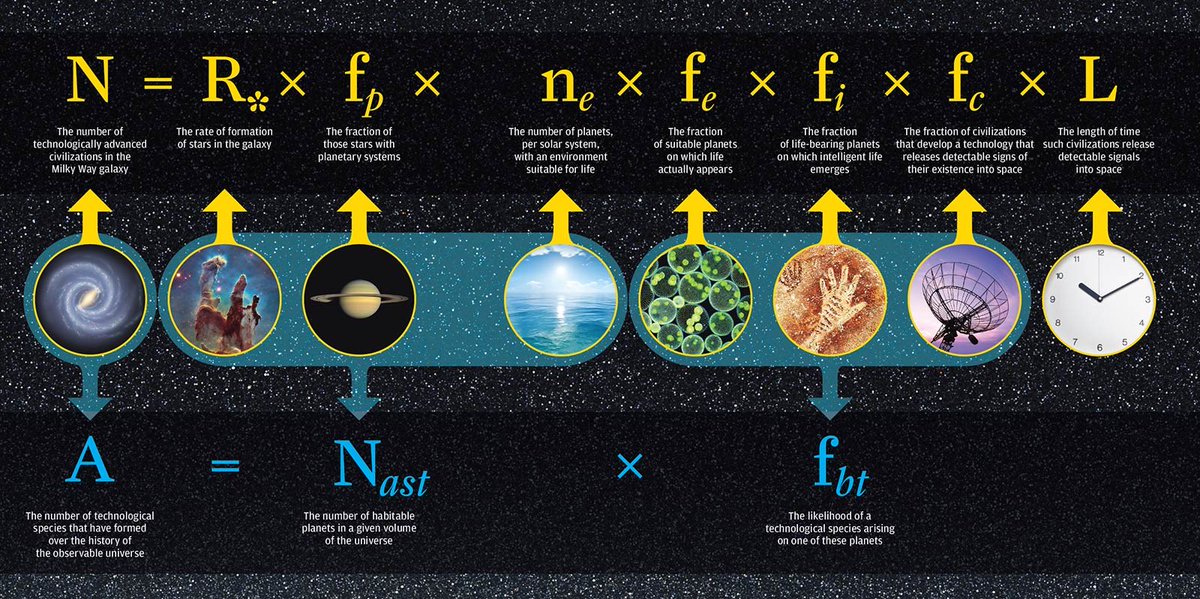For centuries, we have asked this question and attempted to make contact with another civilization. There is actually a fundamental equation that describes this question which was created by Dr. Frank Drake in 1961. It summarizes what scientists would need to contemplate...
(2)
when searching for extraterrestrial life. It is regarded as more of a hypothetical equation, since there is a large uncertainty in many of the variables within it. This means it does not attempt to find a precise number.
Let’s go through each of the variables individually:
(3)
N = the number of theoretically advanced civilizations in the Milky Way galaxy
R* = the rate of formation stars in the galaxy
fp = the fraction of those stars with planetary systems
ne = the number of planets, per solar system, with an environment suitable for life
(4)
fe = the fraction of suitable planets on which life actually occurs
fi = the fraction of life-bearing planets on which intelligent life emerges
fc = the fraction of civilizations that develop a technology that releases detectable signs of their existence into space
(5)
L = the length of time such civilizations release detectable signals space
As you can probably guess, many of these variables are incalculable.
Drake and his colleagues did make some educated guesses in 1961 in order to determine a theoretical value for N, but these were...
(6)
still just guesses.
This equation has been researched and modified a bit by Adam Frank and Woodruff Sullivan (this is shown in the bottom row of the image).
It attempts to answer a slightly different question: What is the number of advanced civilizations likely to have...
(7)
developed over the history of the observable universe?
This question is more broad and allows for us to question the existence of life during the entire lifespan of the universe (which is approximately 13.82 billion years).
Civilizations could have arisen and fallen...
(8)
at any point in that timespan.
However, there is also validity on the other side of the argument, which is that there may be civilizations that come after ours is long gone. We can see this example in Mars and Venus which used to have habitable climates (and maybe life).
(9)
According to Woodruff Sullivan: “For us to have much chance in finding another “contemporary” active technological civilization, on average, they must last longer than our present lifetime.” However, even if we were to make contact with extraterrestrials, we have to...
(10)
look at the sheer distances between objects in the universe due to its size (which is ever-expanding).
Sullivan makes the argument that even if they were 20,000 light years away from us, it would take 40,000 years to make an exchange with them.
(11)
Moving away from the Drake Equation, astronomers are also faced with another dilemma: the Fermi Paradox.
The Fermi Paradox attempts to answer another question on everyone’s minds: “Where is everyone?”
We’ve already talked about the size of the universe, so it would seem...
(12)
likely that we SHOULD have found someone by now. Are we even looking in the “right” places?
Italian physicist Enrico Fermi realized that Earth should have been visited by now by a civilization that wanted to “colonize the galaxy.”
If it “should have” happened, why hasn’t it?
(13)
Micheal Hart wrote an article titled: “An Explanation for the Absence of Extraterrestrials on Earth” in 1975 in order to explain the Fermi Paradox.
In his article, he outlines 4 arguments that explore the paradox.
1. Aliens have not visited us because it is not possible...
(14)
for them.
2. Aliens just chose not to come to Earth (I honestly don’t blame them).
3. Advanced civilizations are too young for aliens to reach us. This means that they may not have developed the technology to do so yet.
4. Aliens have visited Earth in the past, but we...
(15)
have not observed them.
We can not disprove any of these arguments. We would think that aliens would have had “plenty of time” to visit us here on the Pale Blue Dot, but we haven’t considered the cosmic distances that they would have to cross to reach us.
(16)
Something interesting to note is that Fermi first formed his theory long before exoplanets were first discovered. Now, the number of exoplanets is growing rapidly, which gives astronomers hope that perhaps life could be abundant throughout the universe.
There is something...
(17)
to note here. “Life” could mean anything. We are not just talking about it in the sense of an intelligent civilization that has the means to travel great distances across interstellar space. Microorganisms are also considered life. After all, humans even arose from such...
(18)
life forms as well. Pop culture has made it seem that a “Martian invasion” is bound to happen at any moment, which is why I think people are hesitant to say whether they believe in aliens or not. These are my own thoughts of course.
Let’s say life has arisen on another...
(19)
planet. It would need the technological capability to be able to communicate with us here on Earth. It would need to be even more advanced than human civilization in order to visit us from wherever it resides in the universe.
On the Kardeshev Scale, humanity is at a 0.7...
(20)
according to Carl Sagan. This means that we are not even a Type I civilization out of the 3 possible types.
We have not even been able to harness the full amount of energy from our own planet.
This is important to mention, because it is difficult to conceive the amount...
(21)
of energy and technology that it would take another civilization to be able to create and harness in order to reach Earth.
We have only recently been figuring out the field of Astrobiology, which is the study of life (and its origins) in the universe. Life could just be...
(22)
a rarity altogether.
As of right now, we don’t have anyone else to communicate with, but that doesn’t mean that no one’s out there.
They could even be searching for us, but we’re too far away.
There are many, many, many questions that arise from just this one...
(23)
simple question: Are we alone?
It is what many astronomers and physicists hope to answer, or at least get closer to answering in their lifetimes.
(24)
That’s the end of the thread!
Do you believe in aliens? Let me know what you think! ✨
Will we find evidence of life on another planet?
I HIGHLY encourage everyone to check out my blog post, it’s MUCH more detailed and covers everything in more depth.
https://t.co/6mcBSGfmYv







